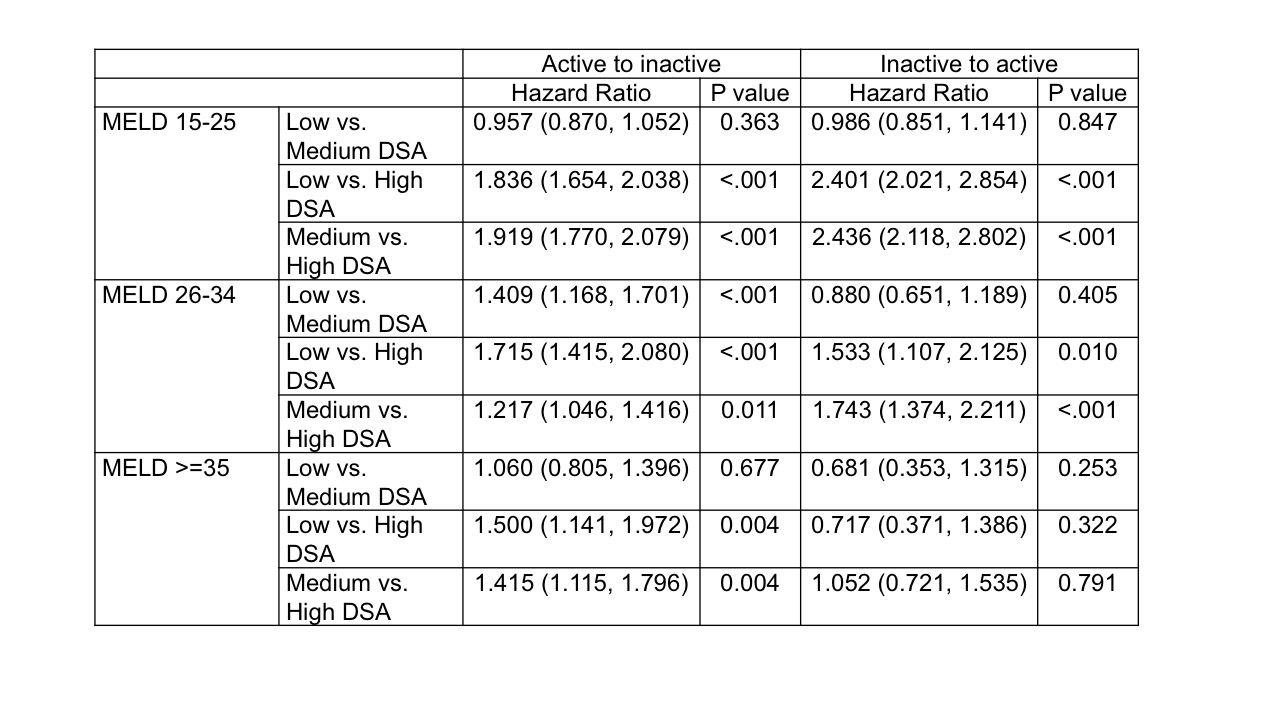Patients in Donor Service Areas with Higher Median MELD at Transplant Have a Lower Probability of Liver Transplant Waitlist Activation
1Yale School of Medicine, New Haven, CT, 2United Network of Organ Sharing, Richmond, VA, 3Yale Center for Analytical Sciences, Yale University, New Haven, CT
Meeting: 2020 American Transplant Congress
Abstract number: B-118
Keywords: Allocation, Liver grafts
Session Information
Session Name: Poster Session B: Liver: MELD, Allocation and Donor Issues (DCD/ECD)
Session Type: Poster Session
Date: Saturday, May 30, 2020
Session Time: 3:15pm-4:00pm
 Presentation Time: 3:30pm-4:00pm
Presentation Time: 3:30pm-4:00pm
Location: Virtual
*Purpose: US allocation of hepatic allografts is prioritized based on medical need, however significant geographical disparities exist with median MELD at transplant across donor specific areas (DSAs) in the current system. Waitlist management practices, specifically activity status changes, could partially account for such disparities as inactive patients cannot receive deceased donor organ offers.
*Methods: To understand whether activity status transitions differ by DSAs we constructed a semi-parametric multistate model, using the OPTN database (06/18/2013 to 06/08/2018). There were nine transitions in this model: active to inactive, active to living donor TX, active to deceased donor TX, active to death/too sick, active to other/well, inactive to active, inactive to living donor TX, inactive to death/too sick, inactive to other/well. For each transition, transition specific cox proportional hazards model was build adjusting for known covariates. DSAs were stratified into tertiles (low, medium, high) by their median MELD at transplant (MMaT). Hazards ratios were calculated between DSA tertile, stratified by MELD group (listing MELD<14,15-25,26-34,>35), to determine statistical significance (p<0.05) in activity status transitions.
*Results: A total of 25,216 subjects were included in the model, of which 29.1% experienced an active to inactive status change. Among these individuals, one (79.3%), two (14.8%), three (4.0%), or four (1.3%) inactive status changes were noted within a 1 year period. Inactive patients with MELD scores < 35 had a higher probability of becoming re-activated in low and medium MMaT DSA’s compared to High MMaT DSA (Table). There was no statistically significant differences in re-activating patients between the low and medium DSA groups across all MELD strata. Low and medium DSA tertiles had a significantly higher probability of having patients transition from active to inactive across MELD categories.
*Conclusions: There are statistically significant differences in activity status transitions based on a DSA’s MMaT. In DSA’s with high MMaT, patients with MELD scores <35 are significantly less likely to be re-activated compared to DSA’s with a low or medium MMaT. Whether this finding is a consequence of differing practice patterns across centers in high MMaT DSAs or is an effect of differing patient populations within these DSAs requires further study.
To cite this abstract in AMA style:
Merola J, Noreen S, Stewart D, Batra R, Haakinson D, Gan G, Deng Y, Kulkarni S. Patients in Donor Service Areas with Higher Median MELD at Transplant Have a Lower Probability of Liver Transplant Waitlist Activation [abstract]. Am J Transplant. 2020; 20 (suppl 3). https://atcmeetingabstracts.com/abstract/patients-in-donor-service-areas-with-higher-median-meld-at-transplant-have-a-lower-probability-of-liver-transplant-waitlist-activation/. Accessed December 15, 2025.« Back to 2020 American Transplant Congress

